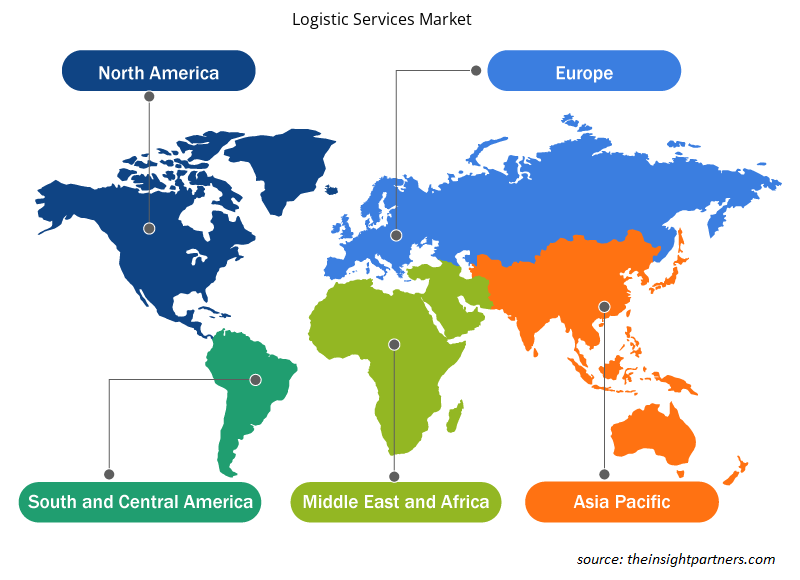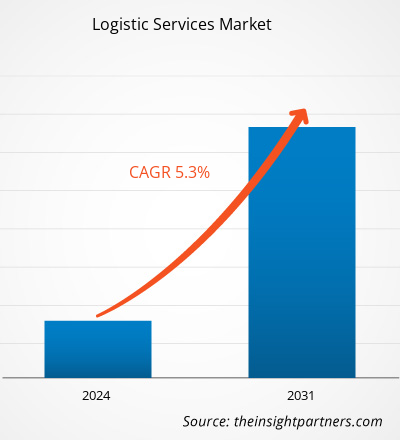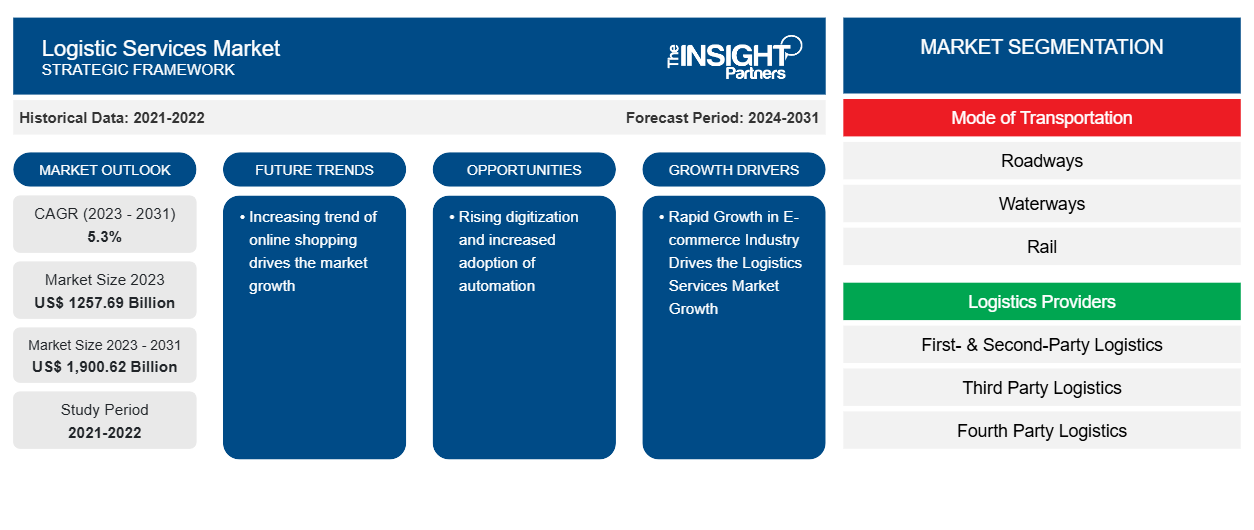من المتوقع أن يصل حجم سوق الخدمات اللوجستية إلى 1900.62 مليار دولار أمريكي بحلول عام 2031 من 1257.69 مليار دولار أمريكي في عام 2023. ومن المتوقع أن يسجل السوق معدل نمو سنوي مركب بنسبة 5.3٪ في الفترة 2023-2031. أدى الطلب المتزايد على عمليات خدمات الخدمات اللوجستية الخارجية مع تحسين عمليات سلسلة التوريد لتقليل التكاليف التشغيلية إلى خلق طلب هائل على نمو سوق الخدمات اللوجستية. كما أدى التبني المتزايد لمقدمي الخدمات اللوجستية من جهات خارجية ومزودي الخدمات اللوجستية من جهات خارجية إلى تعزيز الطلب على سوق الخدمات اللوجستية على مستوى العالم. حاليًا، يشمل مزودو الخدمات اللوجستية الرائدون شركات الشحن وشركات إدارة الشحن وشركات الاستشارات اللوجستية ومقدمي خدمات إدارة المخزون والتخزين واستشارات سلسلة التوريد وغيرها.
كما أن التبني المتزايد لحلول الاتصالات عن بعد القائمة على التكنولوجيا المتقدمة من قبل شركات الخدمات اللوجستية يدفع نمو السوق. ومن المتوقع أن تعمل الخدمات اللوجستية التي تقدم العديد من العمليات مثل التتبع في الوقت الفعلي وتتبع الطرود ومراقبتها وتخطيط المستودعات على دفع نمو سوق الخدمات اللوجستية. إن سوق الخدمات اللوجستية العالمية مجزأة للغاية بسبب الارتفاع السريع في التقدم السريع لصناعة التجارة الإلكترونية بوتيرة سريعة.
تحليل سوق الخدمات اللوجستية
تشمل الخدمات اللوجستية مقدمي الخدمات اللوجستية من الطرف الأول والثاني ، والخدمات اللوجستية من الطرف الثالث (3PL)، والخدمات اللوجستية من الطرف الرابع، والخدمات اللوجستية من الطرف الخامس. تعد الخدمات اللوجستية جزءًا أساسيًا من إدارة سلسلة التوريد. توفر خدمات الخدمات اللوجستية من الطرف الرابع المنتجات للعملاء النهائيين وتزيد من هوامش الربح. تشمل الخدمات اللوجستية جميع عناصر سلسلة التوريد، من تسليم البضائع من المصانع إلى المستهلكين النهائيين. وهي تتكون من نقل البضائع من الشركة المصنعة إلى المستودع، والمستودع إلى الموزعين، وتنفيذ طلبات العملاء، والتسليم للمستخدمين النهائيين. تسهل الخدمات اللوجستية من الطرف الثالث جميع الخدمات اللوجستية كجزء من تنفيذ الطلبات. تشمل الخدمات اللوجستية النقل من المصنع إلى مستودعات التنفيذ، والتخزين وتنفيذ الطلبات، والشحن الخارجي، وتسليم الطلبات من وإلى العملاء.
نظرة عامة على سوق الخدمات اللوجستية
يشمل نقل الخدمات اللوجستية النقل الجوي والسكك الحديدية والممرات المائية والنقل البري. ومن بين هذه الخدمات، يتمتع النقل البري بالحصة الأكبر في عام 2023، ويرجع هذا إلى التبني السريع المتزايد لصناعة التجارة الإلكترونية على المستوى العالمي. كما يشمل النقل المائي حركة البضائع والركاب عبر الأنهار والبحيرات والقنوات والمياه الساحلية. يعد النقل المائي فعالاً من حيث التكلفة لنقل كميات كبيرة من البضائع لمسافات طويلة، ولديه قدرة تحمل عالية مقارنة بالطرق والطرق الجوية. يعد النمو السريع للتصنيع في العولمة مع زيادة أنشطة الاستيراد والتصدير في جميع أنحاء العالم من العوامل الرئيسية الدافعة لنمو سوق الخدمات اللوجستية خلال فترة التنبؤ. تعمل مثل هذه العوامل على دفع نمو سوق الخدمات اللوجستية خلال فترة التنبؤ.
قم بتخصيص هذا التقرير ليناسب متطلباتك
ستحصل على تخصيص لأي تقرير - مجانًا - بما في ذلك أجزاء من هذا التقرير، أو تحليل على مستوى الدولة، وحزمة بيانات Excel، بالإضافة إلى الاستفادة من العروض والخصومات الرائعة للشركات الناشئة والجامعات
-
احصل على أهم اتجاهات السوق الرئيسية لهذا التقرير.ستتضمن هذه العينة المجانية تحليلاً للبيانات، بدءًا من اتجاهات السوق وحتى التقديرات والتوقعات.
محركات وفرص سوق الخدمات اللوجستية
النمو السريع في صناعة التجارة الإلكترونية يدفع نمو سوق الخدمات اللوجستية
يعتمد قطاع التجارة الإلكترونية في الغالب على الخدمات اللوجستية لإدارة عمليات تسليم البضائع للعملاء النهائيين. إن الطلب المتزايد على التسوق عبر الإنترنت في جميع أنحاء العالم، جنبًا إلى جنب مع الارتفاع في انتشار الإنترنت في جميع أنحاء العالم، هو عامل دافع رئيسي لنمو سوق الخدمات اللوجستية خلال فترة التوقعات. بلغت مبيعات صناعة التجارة الإلكترونية في الولايات المتحدة حوالي 1.119 تريليون دولار أمريكي في عام 2023، بزيادة 7.6٪ مقارنة بـ 1.03 تريليون دولار أمريكي في عام 2022. وفي الوقت نفسه، بلغت مبيعات التجارة الإلكترونية بالتجزئة 5.088 تريليون دولار أمريكي في عام 2023، بزيادة 3.8٪ مقارنة بـ 4.904 تريليون دولار أمريكي في عام 2022. هذا النمو السريع في صناعة التجارة الإلكترونية، بسبب العدد المتزايد من مستهلكي التجارة الإلكترونية في جميع أنحاء العالم، يدفع نمو سوق الخدمات اللوجستية خلال فترة التوقعات. مع التوسع المستمر لقطاع التجارة الإلكترونية، زاد الطلب على خدمات التوصيل اللوجستية للميل الأخير أيضًا. تشمل القطاعات الرئيسية التي تدفع نمو سوق الخدمات اللوجستية التجزئة والأدوية والأغذية والمشروبات . علاوة على ذلك، تساهم منتجات قطاع السلع الاستهلاكية سريعة الحركة أيضًا بشكل كبير في نمو سوق الخدمات اللوجستية خلال الفترة المتوقعة.
تزايد التحول الرقمي وزيادة اعتماد الأتمتة
يعد قطاع الخدمات اللوجستية مسؤولاً عن إدارة سلسلة التوريد في قطاع التصنيع. ويشمل نقل السلع والخدمات والمنتجات ذات الصلة. تشهد صناعة الخدمات اللوجستية طلبًا كبيرًا مع التحول الرقمي السريع وتبني الأتمتة. يتبنى مزودو الخدمات اللوجستية بشكل متزايد تقنيات مثل الذكاء الاصطناعي وإنترنت الأشياء (IoT) والتعلم الآلي والروبوتات لتبسيط العمليات اللوجستية وتحسين كفاءة النقل. ويشمل ذلك أتمتة المستودعات وتنفيذ الروبوتات والتحليل التنبئي والمركبات ذاتية القيادة وغيرها.
تقرير تحليل تجزئة سوق الخدمات اللوجستية
إن القطاعات الرئيسية التي ساهمت في استخلاص تحليل سوق الخدمات اللوجستية هي النوع والمنصة والتطبيق والمستخدم النهائي.
- وفقًا لطريقة النقل، يتم تقسيم سوق الخدمات اللوجستية العالمية إلى الطرق السريعة والممرات المائية والسكك الحديدية والطرق الجوية.
- بناءً على مقدمي الخدمات اللوجستية، يتم تقسيم السوق إلى الخدمات اللوجستية للطرف الأول والثاني، والخدمات اللوجستية للطرف الثالث، والخدمات اللوجستية للطرف الرابع، والخدمات اللوجستية للطرف الخامس.
- بناءً على المستخدمين النهائيين، يتم تقسيم سوق الخدمات اللوجستية العالمية إلى الحكومة والمرافق العامة، والرعاية الصحية، والتصنيع الصناعي، وتجارة التجزئة والسلع الاستهلاكية، والفضاء والدفاع، وغيرها.
تحليل حصة سوق الخدمات اللوجستية حسب المنطقة الجغرافية
ينقسم النطاق الجغرافي لتقرير سوق الخدمات اللوجستية بشكل أساسي إلى خمس مناطق: أمريكا الشمالية، وأوروبا، ومنطقة آسيا والمحيط الهادئ، والشرق الأوسط وأفريقيا، وأمريكا الجنوبية.
من المتوقع أن يكون لسوق الخدمات اللوجستية في أمريكا الشمالية الحصة الأكبر وينمو بوتيرة سريعة خلال فترة التنبؤ. في المقام الأول، تنمو صناعة الخدمات اللوجستية بوتيرة سريعة بسبب النمو المتزايد لصناعة التجارة الإلكترونية. تتمتع دول مثل الولايات المتحدة وكندا بحضور كبير لمقدمي الخدمات اللوجستية الرئيسيين، بما في ذلك UPS وFedEx وDHL وCH Robinson. اكتسبت المنطقة طلبًا كبيرًا بسبب الدرجة العالية من الأنشطة التجارية التي تيسرها اتفاقية الولايات المتحدة والمكسيك وكندا (USMCA). علاوة على ذلك، تتمتع المنطقة أيضًا بحضور العديد من التقنيات المتقدمة، مثل الذكاء الاصطناعي والبيانات الضخمة والحوسبة السحابية وإنترنت الأشياء.
رؤى إقليمية حول سوق الخدمات اللوجستية
لقد قام المحللون في Insight Partners بشرح الاتجاهات والعوامل الإقليمية المؤثرة على سوق الخدمات اللوجستية طوال فترة التوقعات بشكل شامل. يناقش هذا القسم أيضًا قطاعات سوق الخدمات اللوجستية والجغرافيا في جميع أنحاء أمريكا الشمالية وأوروبا ومنطقة آسيا والمحيط الهادئ والشرق الأوسط وأفريقيا وأمريكا الجنوبية والوسطى.

- احصل على البيانات الإقليمية المحددة لسوق الخدمات اللوجستية
نطاق تقرير سوق الخدمات اللوجستية
| سمة التقرير | تفاصيل |
|---|---|
| حجم السوق في عام 2023 | 1257.69 مليار دولار أمريكي |
| حجم السوق بحلول عام 2031 | 1,900.62 مليار دولار أمريكي |
| معدل النمو السنوي المركب العالمي (2023 - 2031) | 5.3% |
| البيانات التاريخية | 2021-2022 |
| فترة التنبؤ | 2024-2031 |
| القطاعات المغطاة |
حسب وسيلة النقل
|
| المناطق والدول المغطاة |
أمريكا الشمالية
|
| قادة السوق وملفات تعريف الشركات الرئيسية |
|
كثافة اللاعبين في سوق الخدمات اللوجستية: فهم تأثيرها على ديناميكيات الأعمال
يشهد سوق الخدمات اللوجستية نموًا سريعًا، مدفوعًا بالطلب المتزايد من المستخدم النهائي بسبب عوامل مثل تفضيلات المستهلكين المتطورة والتقدم التكنولوجي والوعي المتزايد بفوائد المنتج. ومع ارتفاع الطلب، تعمل الشركات على توسيع عروضها والابتكار لتلبية احتياجات المستهلكين والاستفادة من الاتجاهات الناشئة، مما يؤدي إلى زيادة نمو السوق.
تشير كثافة اللاعبين في السوق إلى توزيع الشركات أو المؤسسات العاملة في سوق أو صناعة معينة. وهي تشير إلى عدد المنافسين (اللاعبين في السوق) الموجودين في مساحة سوق معينة نسبة إلى حجمها أو قيمتها السوقية الإجمالية.
الشركات الرئيسية العاملة في سوق الخدمات اللوجستية هي:
- سي إتش روبنسون
- دي بي شينكر للخدمات اللوجستية
- خدمة الطرود المتحدة
- إكسبيديتورز الدولية
- جيوديس اللوجستية
- نيبون اكسبريس
إخلاء المسؤولية : الشركات المذكورة أعلاه ليست مرتبة بأي ترتيب معين.

- احصل على نظرة عامة على أهم اللاعبين الرئيسيين في سوق الخدمات اللوجستية
أخبار سوق الخدمات اللوجستية والتطورات الأخيرة
يتم تقييم سوق الخدمات اللوجستية من خلال جمع البيانات النوعية والكمية بعد البحث الأولي والثانوي، والتي تتضمن منشورات الشركات المهمة وبيانات الجمعيات وقواعد البيانات. فيما يلي قائمة بالتطورات في سوق الخدمات اللوجستية والاستراتيجيات:
- في يناير 2023، أطلقت شركة أمازون.كوم خدمة أمازون إير، وهي خدمة أسطول شحن جوي في الهند. تم إطلاق هذه الخدمة لتلبية الطلب المتزايد من قطاع التجارة الإلكترونية. دخلت شركة التجارة الإلكترونية في شراكة مع شركة كويك جيت الهندية لخدمات الشحن الجوي ومقرها مدينة بنغالورو بهدف تسريع تسليم الطرود. (المصدر: DJI، بيان صحفي/موقع الشركة على الويب/النشرة الإخبارية)
- في مارس 2023، أطلقت شركة AP Moller-Merks، وهي شركة لوجستية، خدمة شحن جوي بين بيلوند، الدنمارك، وهانغتشو، الصين. تم إطلاق الخدمة اللوجستية الجديدة للاستجابة للطلب المتزايد من العملاء. (المصدر: Flyability، بيان صحفي/موقع الشركة على الويب/النشرة الإخبارية)
تقرير سوق الخدمات اللوجستية والتغطية والمنتجات النهائية
يوفر تقرير "حجم سوق الخدمات اللوجستية والتوقعات (2021-2031)" تحليلاً مفصلاً للسوق يغطي المجالات التالية:
- حجم السوق والتوقعات على المستويات العالمية والإقليمية والوطنية لجميع قطاعات السوق الرئيسية التي يغطيها النطاق
- ديناميكيات السوق مثل المحركات والقيود والفرص الرئيسية
- الاتجاهات المستقبلية الرئيسية
- تحليل مفصل لـ PEST
- تحليل السوق العالمي والإقليمي الذي يغطي اتجاهات السوق الرئيسية واللاعبين الرئيسيين واللوائح والتطورات الأخيرة في السوق
- تحليل المشهد الصناعي والمنافسة الذي يغطي تركيز السوق، وتحليل خريطة الحرارة، واللاعبين البارزين، والتطورات الأخيرة
- ملفات تعريف تفصيلية للشركة مع تحليل SWOT
- التحليل التاريخي (سنتان)، سنة الأساس، التوقعات (7 سنوات) مع معدل النمو السنوي المركب
- تحليل PEST و SWOT
- حجم السوق والقيمة / الحجم - عالمي، إقليمي، بلد
- الصناعة والمنافسة
- مجموعة بيانات إكسل
التقارير الحديثة
تقارير ذات صلة
شهادات العملاء
سبب الشراء
- اتخاذ قرارات مدروسة
- فهم ديناميكيات السوق
- تحليل المنافسة
- رؤى العملاء
- توقعات السوق
- تخفيف المخاطر
- التخطيط الاستراتيجي
- مبررات الاستثمار
- تحديد الأسواق الناشئة
- تحسين استراتيجيات التسويق
- تعزيز الكفاءة التشغيلية
- مواكبة التوجهات التنظيمية























 احصل على عينة مجانية ل - سوق الخدمات اللوجستية
احصل على عينة مجانية ل - سوق الخدمات اللوجستية